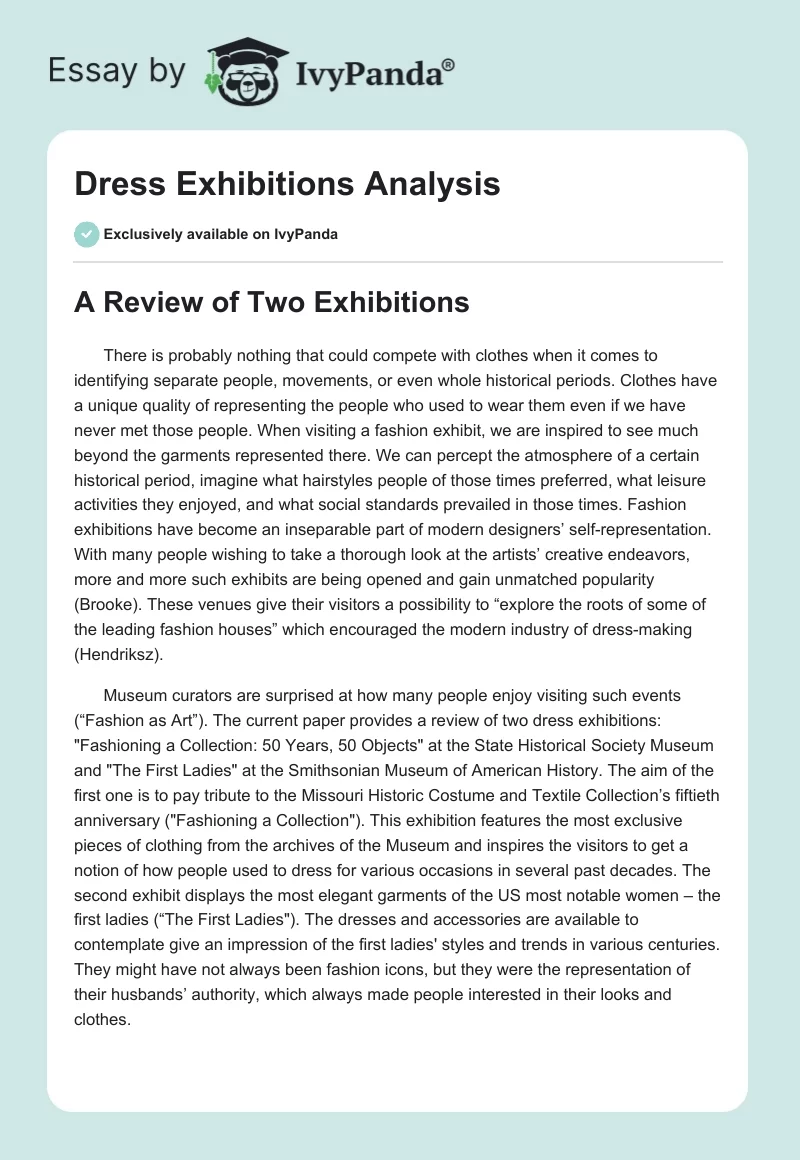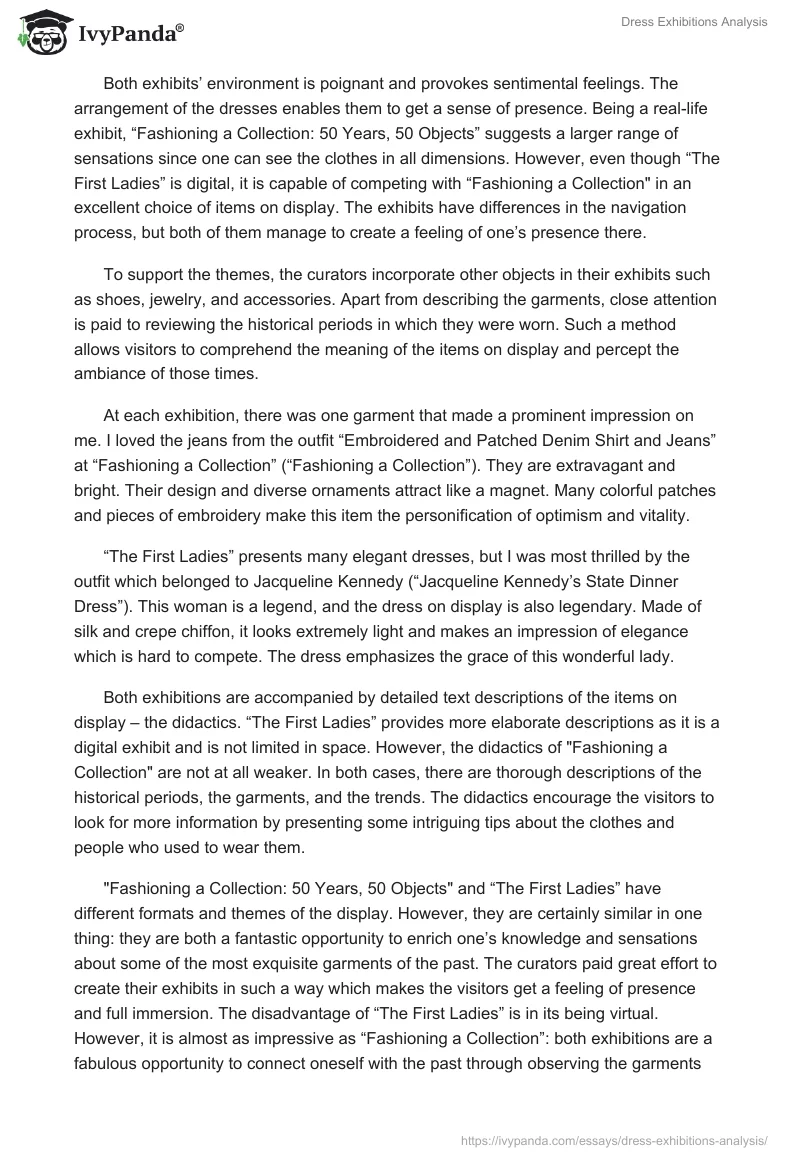A Review of Two Exhibitions
There is probably nothing that could compete with clothes when it comes to identifying separate people, movements, or even whole historical periods. Clothes have a unique quality of representing the people who used to wear them even if we have never met those people. When visiting a fashion exhibit, we are inspired to see much beyond the garments represented there. We can percept the atmosphere of a certain historical period, imagine what hairstyles people of those times preferred, what leisure activities they enjoyed, and what social standards prevailed in those times. Fashion exhibitions have become an inseparable part of modern designers’ self-representation. With many people wishing to take a thorough look at the artists’ creative endeavors, more and more such exhibits are being opened and gain unmatched popularity (Brooke). These venues give their visitors a possibility to “explore the roots of some of the leading fashion houses” which encouraged the modern industry of dress-making (Hendriksz).
Museum curators are surprised at how many people enjoy visiting such events (“Fashion as Art”). The current paper provides a review of two dress exhibitions: “Fashioning a Collection: 50 Years, 50 Objects” at the State Historical Society Museum and “The First Ladies” at the Smithsonian Museum of American History. The aim of the first one is to pay tribute to the Missouri Historic Costume and Textile Collection’s fiftieth anniversary (“Fashioning a Collection”). This exhibition features the most exclusive pieces of clothing from the archives of the Museum and inspires the visitors to get a notion of how people used to dress for various occasions in several past decades. The second exhibit displays the most elegant garments of the US most notable women – the first ladies (“The First Ladies”). The dresses and accessories are available to contemplate give an impression of the first ladies’ styles and trends in various centuries. They might have not always been fashion icons, but they were the representation of their husbands’ authority, which always made people interested in their looks and clothes.
Both exhibits’ environment is poignant and provokes sentimental feelings. The arrangement of the dresses enables them to get a sense of presence. Being a real-life exhibit, “Fashioning a Collection: 50 Years, 50 Objects” suggests a larger range of sensations since one can see the clothes in all dimensions. However, even though “The First Ladies” is digital, it is capable of competing with “Fashioning a Collection” in an excellent choice of items on display. The exhibits have differences in the navigation process, but both of them manage to create a feeling of one’s presence there.
To support the themes, the curators incorporate other objects in their exhibits such as shoes, jewelry, and accessories. Apart from describing the garments, close attention is paid to reviewing the historical periods in which they were worn. Such a method allows visitors to comprehend the meaning of the items on display and percept the ambiance of those times.
At each exhibition, there was one garment that made a prominent impression on me. I loved the jeans from the outfit “Embroidered and Patched Denim Shirt and Jeans” at “Fashioning a Collection” (“Fashioning a Collection”). They are extravagant and bright. Their design and diverse ornaments attract like a magnet. Many colorful patches and pieces of embroidery make this item the personification of optimism and vitality.
“The First Ladies” presents many elegant dresses, but I was most thrilled by the outfit which belonged to Jacqueline Kennedy (“Jacqueline Kennedy’s State Dinner Dress”). This woman is a legend, and the dress on display is also legendary. Made of silk and crepe chiffon, it looks extremely light and makes an impression of elegance which is hard to compete. The dress emphasizes the grace of this wonderful lady.
Both exhibitions are accompanied by detailed text descriptions of the items on display – the didactics. “The First Ladies” provides more elaborate descriptions as it is a digital exhibit and is not limited in space. However, the didactics of “Fashioning a Collection” are not at all weaker. In both cases, there are thorough descriptions of the historical periods, the garments, and the trends. The didactics encourage the visitors to look for more information by presenting some intriguing tips about the clothes and people who used to wear them.
“Fashioning a Collection: 50 Years, 50 Objects” and “The First Ladies” have different formats and themes of the display. However, they are certainly similar in one thing: they are both a fantastic opportunity to enrich one’s knowledge and sensations about some of the most exquisite garments of the past. The curators paid great effort to create their exhibits in such a way which makes the visitors get a feeling of presence and full immersion. The disadvantage of “The First Ladies” is in its being virtual. However, it is almost as impressive as “Fashioning a Collection”: both exhibitions are a fabulous opportunity to connect oneself with the past through observing the garments and getting acquainted with their history. “Fashioning a Collection: 50 Years, 50 Objects” and “The First Ladies” perform a huge aesthetic impression on the visitors.
Works Cited
Brooke, Simon. “The Art of Fashion Exhibitions.” Sotheby’s, 2017. Web.
“Fashion as Art.”CBS News, 2016. Web.
“Fashioning a Collection: 50 Years, 50 Objects.” The State Historical Society Museum, 2017. Web.
Hendriksz, Vivian. “The 10 Must-See Fashion Exhibitions of 2017.”FashionUnited, 2017. Web.
“Jacqueline Kennedy’s State Dinner Dress.” The Smithsonian Museum of American History, n. d. Web.
“The First Ladies.” The Smithsonian Museum of American History, n. d. Web.


